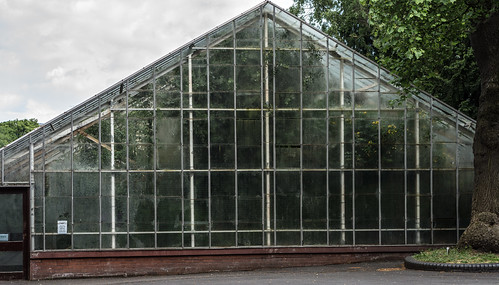I have never visited this area of Belfast before and I must say that I liked the fact the Queen's University, The Botanic Gardens and the Ulster Museum are located beside each other.
The Gardens are attractive but they do not really compare with the Botanic Gardens in Dublin as they are much smaller and while I was there the place was too crowded for my liking. There were many notices indicating that the consumption of alcohol is banned but I certainly saw a number youths drinking beer.
According to Wikipedia: "Belfast Botanic Gardens is a public park in Belfast, Northern Ireland. Occupying 28 acres (110,000 m²) of south Belfast, the gardens are popular with office workers, students and tourists. They are located on Stranmillis Road in Belfast's university area, with Queen's University nearby. The Ulster Museum is located at the main entrance."
The gardens opened in 1828 as the private Royal Belfast Botanical Gardens. It continued as a private park for many years, only opening to members of the public on Sundays prior to 1895. Then it became a public park in 1895 when the Belfast Corporation bought the gardens from the Belfast Botanical and Horticultural Society. The Belfast Corporation was the predecessor of Belfast City Council, the present owner.
The gardens' most notable feature is the Palm House conservatory. The foundation stone was laid by the Marquess of Donegall in 1839 and work was completed in 1840. It is one of the earliest examples of a curvilinear cast iron glasshouse in the world. Designed by Charles Lanyon and built by Richard Turner, Belfast's Palm House predates the glasshouses at Kew and the Irish National Botanic Gardens at Glasnevin. Turner went on to build both of these glasshouses. The Palm House consists of two wings, the cool wing and the tropical wing which contains the dome. Lanyon altered his original plans to increase the height of the dome, allowing for much taller plants. In the past these have included an 11 metre tall Globe Spear Lily. The lily, which is native to Australia, finally bloomed in March 2005 after a 23 year wait. The Palm House also features a 400 year old Xanthorrhoea.
The gardens also contain another glasshouse, the Tropical Ravine House. Built by head gardener Charles McKimm in 1889, it features a unique design. A sunken ravine runs the length of the building, with a balcony at each side for viewing. The most popular attraction is the Dombeya, which flowers every February.
The Palm House and the Tropical Ravine House were symbols of Belfast's growing industrial might and prosperity in the Victorian era and attracted over 10,000 visitors a day. The gardens also feature one of the longest herbaceous borders in the UK and Ireland. The is also a rose garden built in 1932 and various species of tree, including the hornbeam-oak. A statue of Lord Kelvin stands at the Stranmillis Road entrance.
Friday, June 1, 2012
Belfast Botanic Gardens
Subscribe to:
Post Comments (Atom)

No comments:
Post a Comment